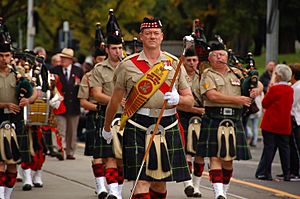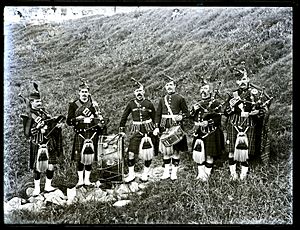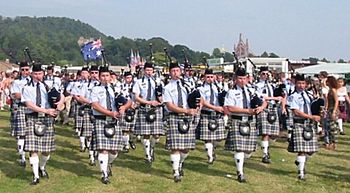Scottish Australians facts for kids
 |
|
| Total population | |
|---|---|
| 2,023,474 (by ancestry, 2016) 119,416 (by birth, 2016) | |
| Languages | |
| English, Scots, Scottish Gaelic | |
| Religion | |
| Presbyterianism, Roman Catholic | |
| Related ethnic groups | |
| Scottish people, Anglo-Celtic Australians, Irish Australians, English Australians, Welsh Australians, Manx Australians |
Scottish Australians (in Scottish Gaelic: Astràilianaich Albannach; in Scots: Scots-Australians) are people living in Australia who have Scottish family roots. They might be fully or partly of Scottish descent.
In 2016, Australia's census showed that 119,416 people living in Australia were born in Scotland. Also, 2,023,474 people said they had Scottish ancestry. This means Scottish ancestry is the fourth most common background in Australia.
Contents
The History of Scottish Australians
The connection between Scotland and Australia started a long time ago. It began with the first British trip by the ship Endeavour. Lieutenant James Cook led this trip. His father was a Scottish farmer. Cook explored and mapped the east coast of Australia. He first landed at Botany Bay on April 29, 1770.
Cook's reports from his expedition led to Britain settling the continent. During his journey, Cook also named two groups of Pacific islands after Scotland: New Caledonia and the New Hebrides. The first European person to die in Australia was a Scot. His name was Forbey Sutherland from Orkney. He died on April 30, 1770, from a lung illness. Captain Cook buried him and named Sutherland Point at Botany Bay in his honor.
Early Settlers and Convicts
The first Scottish settlers came to Australia with the First Fleet in 1788. Three of the first six Governors of New South Wales were Scots. These were John Hunter, Lachlan Macquarie, and Thomas Brisbane. Lachlan Macquarie is often called the "father of Australia."
Many Scots who arrived early were convicts. About 8,207 Scottish convicts were sent to Australia. This was about 5% of all convicts. Scottish courts were less likely to send people to Australia for smaller crimes compared to English and Irish courts. Even though Scottish convicts had a difficult reputation, most were sent for minor property crimes. They brought many useful skills to the new colonies.
From 1793 to 1795, a group of political prisoners arrived. They were called the 'Scottish Martyrs'. They were tried in Scotland, though not all were Scottish. Their story was widely known. One of them, Thomas Muir, escaped in 1796. This caused a stir and inspired the poet Robert Burns.
Most immigrants in the late 1700s were 'free settlers'. They were often wealthy families from the Scottish Lowlands. Engineers like Andrew McDougall and John Bowman came with skills in building mills. Others came for trade opportunities. William Douglas Campbell and Robert Campbell were some of the first merchants.
Several Scottish army units were in the colonies then. These included Macquarie's unit, the Royal North British Fusiliers, and the King's Own Scottish Borderers. Also, three top officials (Deputy Commissaries-General) from 1813 to 1835 were Scots.
Growth and Gold Rush
By 1830, Scots made up about 15% of the colonies' population. This number grew to 25,000 by the mid-1800s, which was 20-25% of the total population. The Australian Gold Rush in the 1850s brought even more Scottish people. About 90,000 Scots immigrated in the 1850s. This was a much higher number than other British or Irish groups at the time. Most Scottish immigrants (90-95%) could read and write.
By the 1830s, more Scots from poorer working classes also moved to Australia. These immigrants included skilled builders, tradesmen, engineers, and printers. They settled in big cities like Sydney, Adelaide, Hobart, and Melbourne. More skilled workers, like bricklayers and stonemasons, also arrived. They settled in Victoria, New South Wales, South Australia, and Tasmania.
In the 1840s, Scots-born immigrants were 12% of Australia's population. From 1861 to 1914, 13.5% of all migrants from Britain to Australia were Scots. Many came after difficult times in Scotland, like the Highland Potato Famine and the Highland Clearances. By 1860, Scots made up 50% of the population in Western Victoria, Adelaide, Penola, and Naracoorte. Other Scottish settlements were in New England, the Hunter Valley, and the Illawarra in New South Wales.
Scottish migrants often worked in farming and government jobs in Australia's early days. Some were involved in unfair actions against Indigenous Australians. This included taking their lands and creating unfair rules.
Throughout the 1800s, Scots invested a lot in Australian industries. The Scottish Australian Investment Company, started in 1840, became a major business. It invested heavily in farming and mining. Before the 1893 Australian financial crisis, Scotland was the main source of private British loans to Australia.
20th Century and Today

Scottish immigration continued into the 1900s. Many Scots kept arriving after 1945. Between 1910 and 1914, about 9,000 Scots came each year. By 1921, 109,000 Scottish people lived in Australia. After World War I, Scotland faced economic problems. This meant many Scots moved to Australia between the wars. By 1933, 132,000 Scottish migrants lived in Australia.
In the 1920s and 1930s, most Scottish migrants lived in Victoria and New South Wales. Many came from working-class backgrounds in cities. They often settled in industrial areas near ports, especially in Melbourne and Sydney. They helped a lot with shipbuilding. Scottish-born workers also had a big impact on the labor movement. They played key roles in trade unions and the Australian Labor Party. Some even became leaders in the Communist Party of Australia.
Today, Scottish culture is strong in Australia. You can see it in Highland games, dance, Tartan Day celebrations, and Gaelic speaking groups. In the early 2000s, the number of Australians claiming Scottish ancestry almost tripled. Most of these people are third generation Australians or later.
Scottish Culture in Australia
Many parts of Scottish culture are found in Australia:
- Bagpiping and pipe bands are very popular.
- Burns Suppers celebrate the poet Robert Burns.
- Ceilidhs are traditional Scottish social gatherings with music and dancing.
- Hogmanay is the Scottish New Year celebration.
- Presbyterianism is a Christian faith. Most Scottish settlers were Presbyterian.
- Tartan is a patterned cloth. Some areas of Australia even have their own tartan designs.
- Tartan Day in Australia is on July 1. This date marks when a law banning Scottish national dress was removed in 1792.
Highland Gatherings
Highland gatherings are popular events in Australia. They celebrate Scottish culture. Some famous gatherings include:
- Bundanoon, New South Wales: Started in 1976, it is one of the largest Highland Gatherings in the Southern Hemisphere.
- Maclean, New South Wales: First held in 1904. It brings pipe bands from all over Australia for parades and dancing.
- Maryborough, Victoria: Held since 1857 on New Year's Day.
Scottish Schools
Scots in Australia started many schools. Some are public, and some are private:
- The Scots College, in Bellevue Hill, Sydney, New South Wales.
- Presbyterian Ladies College PLC in Croydon, New South Wales.
- The Scots PGC College, in Warwick, Queensland.
- The Scots School Albury, in Albury, New South Wales.
- The Scots School, Bathurst, in Bathurst, New South Wales.
- Presbyterian Ladies' College, Armidale PLCA in Armidale, New South Wales.
- Scotch College, Adelaide, in Torrens Park and Mitcham, South Australia.
- Scotch College, Melbourne, in Hawthorn, Victoria.
- Scotch College, Perth, in Swanbourne, Western Australia.
- Presbyterian Ladies College, Perth, in Peppermint Grove, Western Australia.
- Scotch College, Launceston, in Tasmania. It joined with Oakburn College in 1979 to form Scotch Oakburn College.
- Seymour College, Adelaide, South Australia.
Scottish Place Names in Australia
In Australia, about 17% of all non-Indigenous place names are Scottish. Many come from the Scottish Lowlands. But Highland names are also common where many Highland Scots settled. There are also many other places, properties, and streets in Australia with Scottish names.
Some well-known Scottish place names in Australia include:
- Western Australia
- New South Wales
- Northern Territory
- Queensland
- Brisbane (named after Thomas Brisbane)
- South Australia
- St Kilda
- Stirling
- Glenelg
- Tasmania
- Ben Lomond
- Lake Mackintosh
- Suburbs of Hobart-Glenorchy-
- Glenorchy & City of Glenorchy
- Victoria
Places Named After Lachlan Macquarie
Many places in Australia are named after Lachlan Macquarie. Some he named himself.
Named during or soon after his time as governor:
- Macquarie Island between Tasmania and Antarctica.
- Lake Macquarie in New South Wales.
- Macquarie River in New South Wales, passing through cities like Bathurst and Dubbo.
- Lachlan River, another important river in New South Wales.
- Port Macquarie, a city on the coast of New South Wales.
- Macquarie Pass, a route through mountains in New South Wales.
- Macquarie Rivulet, a river in New South Wales.
- In Tasmania:
- Macquarie Harbour on the west coast.
- Lachlan, a small town.
- Macquarie River.
- Macquarie Hill in New South Wales.
- Lachlan Swamps in Centennial Parklands.
Named many years after his time as governor:
- Macquarie Park and Macquarie Links, suburbs of Sydney.
- Macquarie, a suburb of Canberra.
- Division of Macquarie, a voting area for the Australian Parliament.
Famous Australians with Scottish Roots
Many well-known Australians have Scottish heritage. Here are a few:
- Captain James Cook (1728–1779): An explorer and navigator. He was the son of a Scottish farmer.
- Lachlan Macquarie (1762–1824): The fifth governor of New South Wales. He is often called the "Father of Australia."
- Andrew Fisher (1862–1928): He was the Prime Minister three times. He was born in Ayrshire, Scotland.
- Mary MacKillop (1842–1909): A Roman Catholic nun and the only Australian to be made a saint. Her parents were Scottish immigrants.
- John Flynn (minister) (1880–1951): A Presbyterian minister who started the Royal Flying Doctor Service. His church was the Church of Scotland.
- Catherine Helen Spence (1825–1910): An author, journalist, and Australia's first female political candidate. She was born in Melrose, Scotland.
- Peter Dodds McCormick (1834?–1916): He wrote Australia's national anthem, Advance Australia Fair. He was born in Port Glasgow, Scotland.
- Bon Scott (1946–1980): The lead singer of the famous band AC/DC. He was born in Forfar, Scotland.
- Angus Young (1955–): The guitarist for AC/DC. He was born in Glasgow, Scotland.
- Malcolm Young (1953–2017): Also a guitarist for AC/DC. He was born in Glasgow, Scotland.
- Colin Hay (1953–): The lead singer of the band Men at Work. He was born in North Ayrshire, Scotland.
- Miranda Kerr (1983–): A famous Australian supermodel. She has Scottish ancestry.
- Mary, Crown Princess of Denmark (1972–): Born in Hobart, Tasmania, she has a Scottish father.
- Robert Menzies (1894–1978): A Prime Minister. His grandparents were Scottish.
- Isla Fisher (1976–): A Hollywood actress. She was born to Scottish parents in Oman and grew up in Perth, Australia.
- James Boag I (1804–1890): He founded Boag's Brewery in Tasmania. He was born in Paisley, Scotland.
- Roy Cazaly (1893–1963): A legendary Australian Rules Footballer. His mother was Scottish.
- John Malcolm Fraser (1930–2015): A Prime Minister. His father was Scottish.





